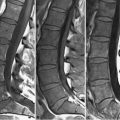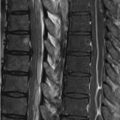52 Leptomeningeal Carcinomatosis The presence of metastatic disease to the leptomeninges is a poor prognostic indicator, occurring most commonly with primary CNS neoplasms—so-called drop metastases most frequently from medulloblastoma, glioblastoma, ependymoma, and pineal tumors. Non-CNS culprits include most frequently primary breast followed by lung cancers. Due to the effects of gravity, the lumbar spine is most commonly involved. The appearance of such lesions is variable on MRI. Findings in a patient with primary breast carcinoma are illustrated in Figs. 52.1A,B,C. Sagittal T2WI (A) demonstrates small moderate SI nodules involving the cauda equina. (B) Axial contrast-enhanced T1WI just above the level of termination of the conus demonstrates brightly enhancing lesions, typical of metastases to this structure. At the (C) level of the tip of the conus, axial contrast-enhanced T1WI display brightly enhancing small nodules surrounding but sparing the conus. More superiorly in the cord, in the cervical spine of the same patient, an enhancing intramedullary lesion is seen on the contrast-enhanced T1WI of Figs. 52.1D,E (white arrow). Enhancement indicative of involvement of the dorsal pia-arachnoid is present as well both on (D) sagittal and (E) axial contrast-enhanced T1WI. Whether this particular tumor represented a primary metastasis to the dura now involving the cord or alternatively a primary intramedullary metastasis now involving the dura remains indeterminant.
Stay updated, free articles. Join our Telegram channel

Full access? Get Clinical Tree








